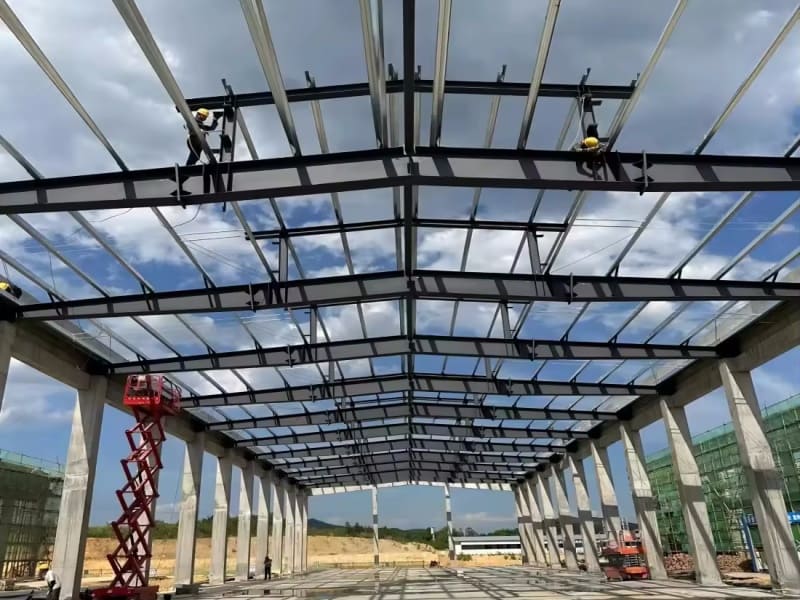The first step in planning a modern steel structure workshop is to evaluate which building configuration best meets your operational needs. Whether you are constructing a steel construction warehouse for storage, a prefab metal warehouse for logistics, or a steel structure workshop with bridge crane for manufacturing, the choice of design will directly impact efficiency, safety, and future scalability.
Common Workshop Types
♦1. Single Span Steel Structure Workshop
A single-span design eliminates the need for internal columns, providing a clear and open interior layout. This is especially advantageous for facilities that require maximum usable floor space, such as logistics hubs, packaging centers, and large-scale production lines. In industries where material handling equipment or vehicles need unobstructed movement, a single-span prefab metal warehouse offers excellent flexibility. Its uninterrupted space allows for seamless workflow optimization, making it an ideal solution for companies prioritizing efficiency and storage capacity.
♦2. Multi Span Steel Structure Workshop
For operations that require multiple sections or varying roof heights, the multi-span configuration is the preferred choice. By dividing the workshop into several spans supported by internal columns, this design provides increased stability and the ability to accommodate different industrial processes under one roof. Automotive assembly plants, heavy machinery manufacturing, and large steel construction warehouse facilities often adopt multi-span layouts to separate production, assembly, and storage areas. A steel structure workshop with bridge crane is often incorporated in these designs, supporting heavy-duty lifting and streamlining material flow between different sections.
Key Design Considerations
♦Load-Bearing Capacity
The structural integrity of any steel structure workshop depends on its ability to handle anticipated loads. These include construction loads, equipment loads, wind, snow, and even seismic factors. For example, a steel structure workshop with bridge crane requires additional calculations to accommodate the crane’s weight, lifting capacity, and the dynamic forces generated during operation. Engineers must also account for the strength and spacing of purlins, roof sheets, and supporting beams to prevent structural failures. Proper load distribution ensures that both prefab metal warehouses and heavy-duty workshops can operate safely and efficiently.
♦Portal Steel Frame Design
Portal frames form the backbone of most steel construction warehouses and workshops. Depending on project requirements, the design may include single ridge and single slope, double slope, or multi-ridge structures. For heavy industrial applications, such as a steel structure workshop with bridge crane, rigid frames with a constant cross-section are often used to support significant loads. Portal frames not only provide durability but also allow for wide spans without compromising stability. Advanced engineering techniques, including finite element analysis (FEA), are commonly applied to ensure that the chosen frame design delivers optimal performance.
♦Material Selection and Quality
Material choice directly influences the durability, cost-effectiveness, and longevity of a steel construction warehouse. High-strength steel is suitable for larger spans and heavy-duty applications, while galvanized steel provides enhanced protection against corrosion, making it a good option for humid or coastal environments. For a prefab metal warehouse, cost-efficiency and ease of assembly are often top priorities, while industrial workshops require stronger steel grades to handle demanding operations.
Beyond structural steel, attention must also be given to cladding and insulation materials. Insulated panels, fiberglass, or mineral wool not only enhance energy efficiency but also provide acoustic benefits, which are critical in noisy industrial environments. For facilities with cranes, using robust materials ensures the building can endure both static and dynamic forces without compromising safety.
Choosing the right design for your steel structure workshop involves balancing operational requirements, budget, and long-term growth plans. A single-span layout is ideal for open spaces and flexible use, while a multi-span structure suits industries with diverse production processes. When heavy lifting is required, incorporating a steel structure workshop with bridge crane ensures maximum efficiency and safety. Similarly, a steel construction warehouse provides robust storage solutions, and a prefab metal warehouse offers cost-effective, quick-to-install options for logistics and manufacturing. By carefully considering load capacity, portal frame design, and material selection, businesses can invest in a workshop that is durable, efficient, and tailored to future needs.









